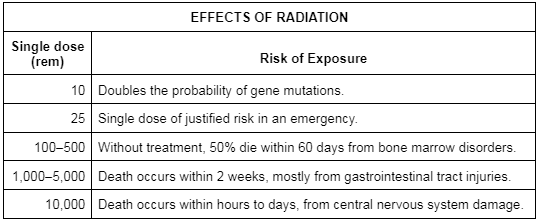When working with or near radiation from man-made technology or radionuclides, it’s important that you’re aware of the risks involved and precautionary mitigating measures. Although you’re unlikely to suffer serious short-term effects, radiation is cumulative. Over time, you may become susceptible to health issues such as cancer and cardiovascular disease.
Tips for Working With or Near Radiation Safely
The following points are essential best practices for all radiologic staff. Follow these safety precautions when working with radiation, to reduce possible hazards:
- Always strive to practice the ALARA principle – As Low As Reasonably Achievable
- Follow the instructions of the designated Radiation Safety Officer who leads/participates in regular safety meetings, monitors radiation levels, and ensures that the proper protections are in place.
- Ensure that you are properly equipped with certified Personal Protective Equipment (PPE) and/or shielding when necessary.
Remember the Basic Principles for Radiation Protection
The ALARA Principle is achieved by following 3 rules:
- Time: Minimizing exposure time reduces the radiation dose. Work quickly and efficiently to spend the least possible amount of time in close proximity to the radioactive source.
- Distance: As distance increases from the radiation source, the radiation dose decreases dramatically. This follows an inverse square law, for example, if you double the distance, radiation intensity drops to a quarter. Even a few extra steps can make a huge difference.
- Shielding: Inserting the proper shielding and wearing radiation PPE greatly reduces or eliminates the dose received. Barrier Technologies develops innovative shielding products.
Control of External Radiation Exposure
External radiation exposure comes from outside the body and interacts with us. The source could be from radiography equipment, such as an x-ray machine, or radioactive materials in a container.
You should be aware of the risks associated with the specific type of radiation you work with. Electromagnetic radiation, such as x-rays or gamma rays, passes through the body and could be dangerous.
#1. Use Personal Protective Equipment (PPE) to Protect Employees From Radiation
Always be prepared for possible emergencies when working with or near radiation. You should wear high-quality, certified PPE whenever you’re in the Radiation Controlled Area (RCA). The type of PPE depends on the type of radiation being utilized.
Barrier Technologies supplies Leaded Eyewear, Lead and Lead-free Aprons, Protective Gloves, Scatter Reducing Pads and Drapes, Patient CT Shields, Mobile Barriers, and X-ray Accessories.
#2. Dose Limits for Radiation Workers
Federal legislation requires that workers exposed to >100 millirem/year receive training in protection against radiation, and be informed of the exposure amount. Furthermore, the Nuclear Regulatory Commission (NRC) may be requested to inspect a workplace if there’s a safety issue. The whole body’s Total Effective Dose Equivalent (TEDE) is 5,000 millirem/year. The table below shows dose limits:
#3. Dosimeter Badges
Dosimeter badges don’t protect you from radiation – they document your occupational radiation exposure to comply with annual dose limits and ALARA levels, and inform the Radiation Safety Officer about radiation safety in your RCA.
The following tips will help you keep a good record of the dose of external radiation you’ve received:
- Wear your dosimeter every time you’re in the RCA.
- Wear the badge at or near your collar, as close to your thyroid gland as possible.
- Don’t share the dosimeter, don’t tamper with it, and don’t take it home.
- Turn it in promptly and check your dosimetry report often.
Control of Internal Radiation Exposure
Internal radiation exposure occurs when radioactive material enters the body, by breathing, eating, or passing through the skin. The internalized radiation energy then gets absorbed into cells, tissues, and organs.
#1. Prevent the Risk of Internal Radiation Exposure
Take heed of the following dos and don’ts:
- Do use proper radiation shielding in the RCA.
- Do wear proper PPE in the RCA.
- Do frequent radiation surveys of the RCA and promptly decontaminate “hot spots”.
- Do monitor your clothing and body for radioactivity frequently, and after your work shift.
- Do wash your hands thoroughly with nonabrasive soap and water after using radioisotopes, before leaving the RCA, and before mealtimes.
- Don’t touch suspected contamination, nor anything or anyone that had contact with it.
- Don’t eat or drink in the RCA.
- Don’t apply makeup in the RCA.
- Don’t smoke in the RCA.
#2. Radiation Detection
A radiation survey meter is a portable, handheld radiation detector used to establish the presence and quantity of radiation. Most only detect beta and gamma radiation, but some advanced models can detect gamma and x-rays, and alpha, beta, and neutron radioactive particles. Some survey meters have a telescoping probe to allow the operator to test at a distance from the suspected radiation. Before use, always check for a valid, up-to-date calibration sticker. The NRC requires meters to be calibrated annually.
#3. Scintillation Detection
Scintillation refers to the flashes of light emitted when a transparent substance is struck by high-energy radioactive particles or photons. The frequency and intensity of the flashes are proportional to the amount and energy of the radiation. Scintillation measurement devices, such as detectors, counters, and cameras, count these flashes to a very high degree of accuracy. Such devices provide an instant dose reading without interfering with the ionizing radiation.
Risks of Radiation Exposure
The table shows risks of single exposure dosage
Takeaway
Always promote safety by combining best practices and precautionary measures when working with or near radiation. Follow the guiding principle of ALARA and understand the risks of the type of radiation in your workplace. At Barrier Technologies, “Your Safety is Our Concern”. Our innovative Radiation Protection Products help to keep people safe from the harmful effects of radiation. Contact us today for expert advice.
More Helpful Readings:





